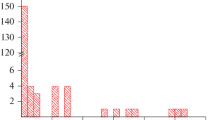Abstract
In this paper main implication of basic properties detected in the satellite systems of Jupiter, Saturn and Uranus, and presented by the author in an earlier contribution (Barricelli, 1971b) are investigated. The similarity between the primary periods in the three systems, their apparent relation to the axial rotation periods of the three planets and other features suggesting that collisions with the planetary surfaces may have played a role in the evolution of the three satellite systems are interpreted by assuming that in each case a satellite of unusually large size was originally disintegrated at the Roche limit of its primary. The disintegration of large satellites and their fusion with the respective planets is assumed to be a normal feature in the latest stage of planetary growth and the main cause of axial rotation in the respective planets.
These assumptions make it possible to give a selfconsistent interpretation of the similarity between the axial rotation periods of the three planets and their relation to the primary periods (as defined by Barricelli, 1971b) in the three systems.
Similar assumptions when applied to the Earth-Moon system make it possible to understand why the Moon, in its closest approach to the Earth is found to have been almost exactly at the Roche limit (Gerstenkorn, 1955; MacDonald, 1964), a coincidence which is too good to be accidental. According to this interpretation our Moon is a portion (representing about one third) of our original satellite, which survived its approach to the Roche limit and the ensuing fusion process with the Earth. It can be shown (see text) that under certain conditions this could leave a residual satellite with a stationary distance from the Earth (which in retrospect would be identified as its lowest distance from the Earth) at the Roche limit.
The only other case in which we have observational evidence of parts of a satellite surviving its fusion process at the Roche limit is represented by the rings of Saturn and possibly the small innermost satellite Janus which seems to have been feeding on the rings.
Similar content being viewed by others
References
Alfvén, H.: 1963,Icarus 1, 357–363.
Alfvén, H.: 1969,Astrophys. Space Sci. 4, 84.
Barricelli, N. Aall and Metcalfe, R.: 1969,Icarus,10, 144–163.
Barricelli, N. Aall: 1971a, ‘Preferential Perihelion and Aphelion Distances’ (submitted toIcarus).
Barricelli, N. Aall: 1971b, ‘Meeting Distances in Three Satellite Systems, General Characteristics of the Systems Involved’ (submitted toIcarus).
Barricelli, N. Aall: 1971c, ‘Jet Streams, Meeting Distances and Their Relation to Perihelion and Aphelion Distances’ (submitted toIcarus).
Gerstenkorn, H.: 1955,Z. Astrophys. 36, 245–274.
MacDonald, G. J. F.: 1964,Rev. Geophys. 2, 467.
The Handbook of the British Astronomical Association, 1951 and 1958, The Vincent-Baxter Press, Oxford, Great Britain.
Urey, H.: 1952,The Planets, pp. 30–39, Yale Univ. Press, New Haven, Connecticut.
Urey, H. 1962, in Z. Kopal (ed.) ‘Origin and History of the Moon’,Physics and Astronomy of the Moon, pp. 481–253, Academic Press, New York.
Author information
Authors and Affiliations
Rights and permissions
About this article
Cite this article
Barricelli, N.A. The transmission of mass and angular momentum from a satellite or planetary system to its primary. Astrophys Space Sci 15, 479–501 (1972). https://doi.org/10.1007/BF00649774
Received:
Issue Date:
DOI: https://doi.org/10.1007/BF00649774




